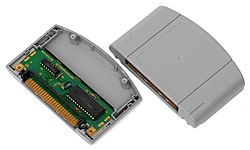Nintendo 64 Game Pak

Open and unopened N64 Game Pak
|
|
| Media type | ROM cartridge |
|---|---|
| Encoding | Digital |
| Capacity | 32–512 Mbit |
| Developed by | Nintendo |
| Usage | Nintendo 64 |
Nintendo 64 Game Pak (NUS-006) are ROM cartridges that store game data for the Nintendo 64. Their sizes vary from 4 MiB (32 Mbit; e.g. Automobili Lamborghini and Dr. Mario 64) to 64 MiB (512 Mbit; e.g. Resident Evil 2 and Conker's Bad Fur Day). The Game Pak's design tradeoffs were intended to achieve maximal system speed and minimal system cost, with a lesser storage space and a higher unit cost per game.
Launched in 1996, the Nintendo 64 was the last major home console to use a cartridge as its primary storage format until the release of the Nintendo Switch in 2017, although it is debatable as to whether or not the Switch actually constitutes a home console in the traditional sense. Nintendo's data storage strategy with the Nintendo 64 had always been to develop a complementary higher-capacity disk-based peripheral, the 64DD, to accompany the Nintendo 64 Game Pak. This resulted in 1999's 64DD, an aftermarket peripheral which was launched years late and only in Japan as a commercial failure, leaving the Game Pak as the console's only storage medium.
To complement the company's two previous high-speed cartridge-based console generations, Nintendo had already developed high-capacity secondary storage devices such as the Famicom Disk System and the cancelled SNES-CD. The company had always intended to do likewise with this generation. In a 1994 interview, Nintendo summarized its analysis of the continued advantages of cartridges for its upcoming console, eventually known as the Nintendo 64.
Right now, cartridges offer faster access time and more speed of movement and characters than CDs. So, we'll introduce our new hardware with cartridges. But eventually these problems with CDs will be overcome. When that happens, you'll see Nintendo using CD as the software storage medium for our 64-bit system.
That sentiment was soon revised; also in 1994, Nintendo's vice president of marketing Peter Main stated that "The choice we made is not cartridge versus CD, it's silicon over optical. When it comes to speed, no other format approaches the silicon-based cartridge."
...
Wikipedia
